| November 16, 2018
Riding The Scalpel
Chris Fillmore made it famous, now we get to ride the production KTM 790 Duke at the U.S. launch in Southern California. This is gonna be good!
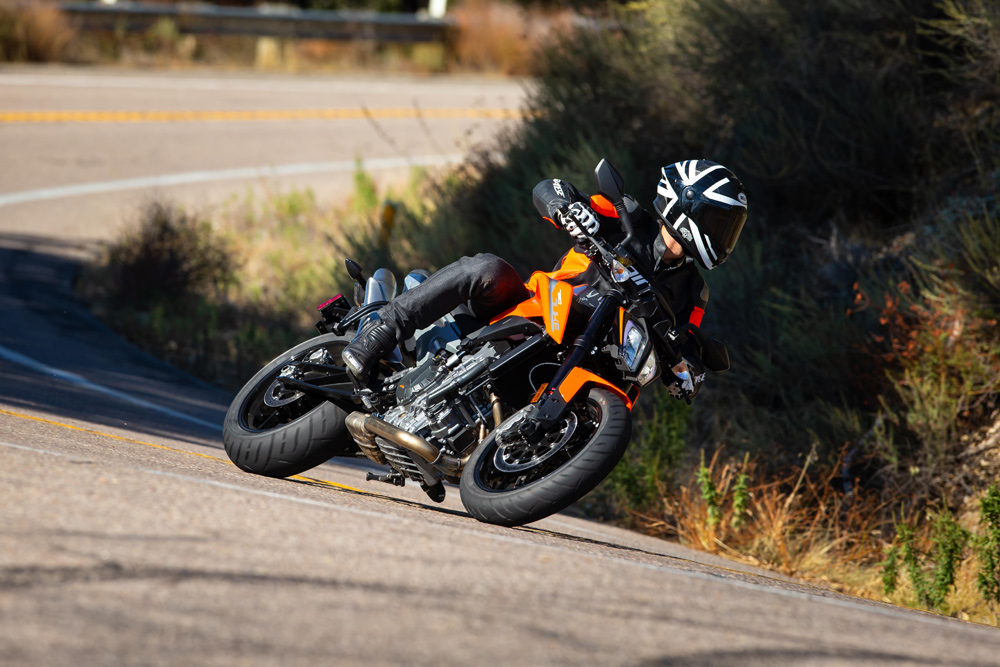 This KTM 790 Duke hunts apexes for sport.
This KTM 790 Duke hunts apexes for sport.
In short, the 2019 KTM 790 Duke is basically the moto-version of your psycho ex-girlfriend, but one your current significant other still lets you hang around and get frisky with—and getting frisky is this Duke’s forte.
Ever since KTM unveiled the 790 Duke prototype at EICMA in late 2016, the news spread like wildfire among sport bike enthusiasts all over the world. Work on this all-new middleweight destroyer, however, dates back to 2012, when KTM began engineering its first ever parallel-Twin—the heart of what they call “The Scalpel.”
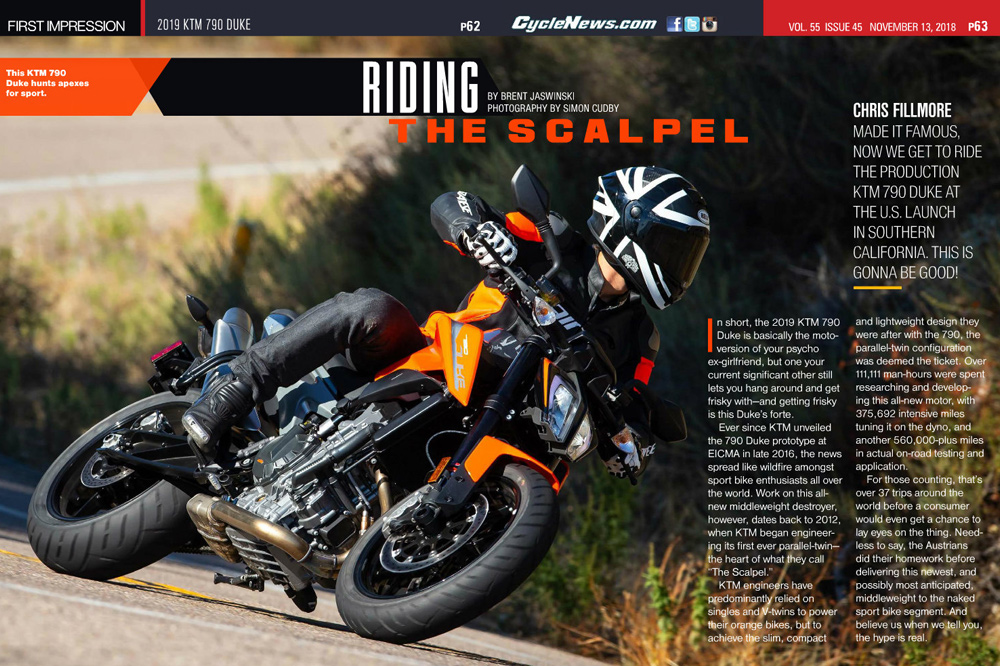
By Brent Jaswinski | Photography by Simon Cudby
KTM engineers have predominantly relied on singles and V-twins to power their orange bikes, but to achieve the slim, compact and lightweight design they were after with the 790, the parallel-twin configuration was deemed the ticket. Over 111,111 man-hours were spent researching and developing this all-new motor, with 375,692 intensive miles tuning it on the dyno, and another 560,000-plus miles in actual on-road testing and application.
For those counting, that’s over 37 trips around the world before a consumer would even get a chance to lay eyes on the thing. Needless to say, the Austrians did their homework before delivering this newest, and possibly most anticipated, middleweight to the naked sport bike segment. And believe us when we tell you, the hype is real.
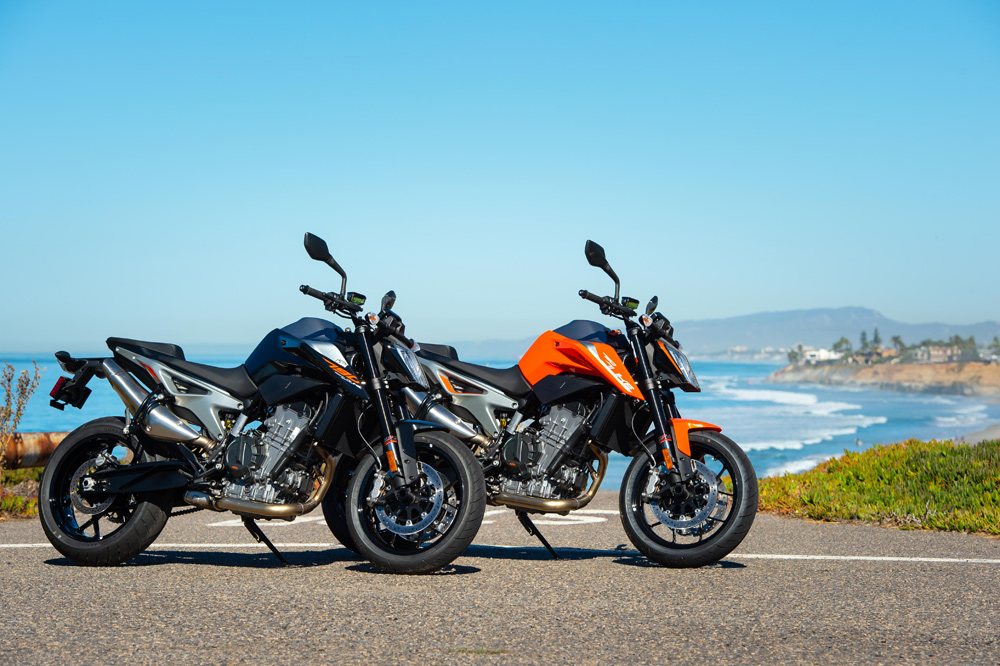 The U.S will get two color options for 2019. The black looks unsurprisingly mean.
The U.S will get two color options for 2019. The black looks unsurprisingly mean.
Knife Edge
Dubbed the LC8c (for liquid-cooled, eight-valve, compact), the DOHC 799cc engine cranks out a claimed 105 horsepower at 9000 rpm and 64 ft-lb of torque at 8000 rpm. Given its 373-pound dry weight, that’s a healthy power-to-weight ratio to excite even the most hardcore performance junkies. Slotting the gap between the 690 Duke and the 1290 Super Duke R, the 790’s parallel-twin configuration was chosen to strike a balance between the agility of a single with the punch of a bigger V-twin.
Getting this combination right initially created some engineering obstacles, though. After considering the idea of potentially downsizing one of their bigger, 75-degree twins, the plan was ultimately scrapped. KTM’s goal with the 790 wasn’t just to plug a smaller (or bigger) engine into a preexisting chassis. Instead, the company wanted to introduce an entirely new bike to its lineup—one with handling and performance as sharp as its name would suggest.
The 790 engine, with its 75-degree crankpin offset and 435-degree firing interval, is primarily tuned for midrange torque, and it’s got a seductively raspy exhaust note thanks to its irregular firing order. It snaps to attention with the slightest crack of the throttle, and continues to build power as the revs climb to their 9200 rpm limit.
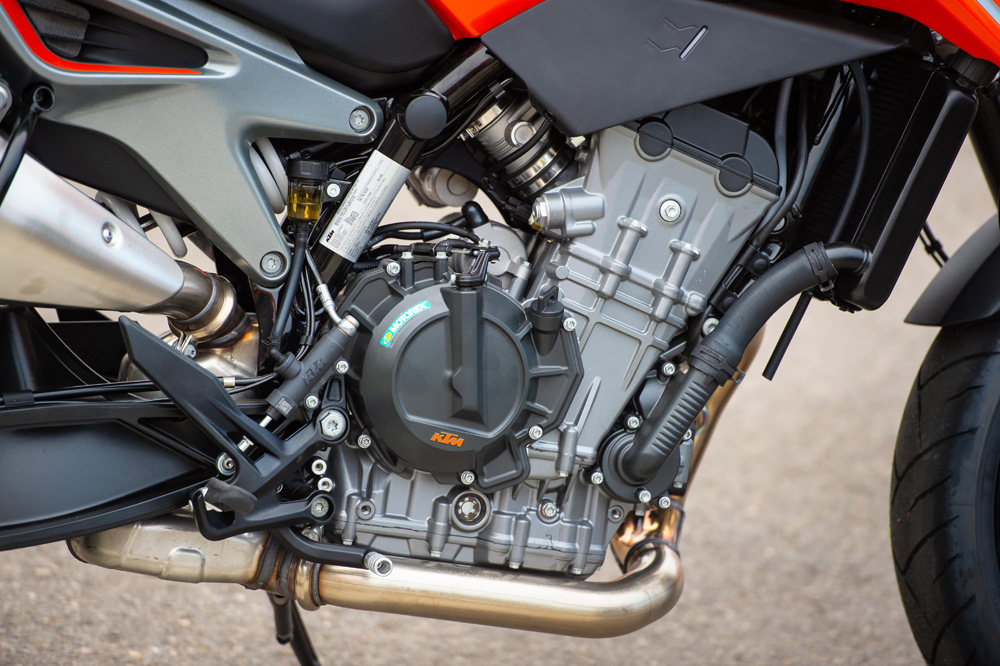 The LC8c engine weighs only 110 pounds without the throttle bodies, and 116 with them.
The LC8c engine weighs only 110 pounds without the throttle bodies, and 116 with them.
Keeping with KTM’s competitive, “Ready to Race” nature, engineers made sure the 790’s top-end pull was equally as impressive as its midrange punch while rocketing you towards triple-digit, go-to-jail speeds. Fortunately, keeping all that power in check is the most advanced electronic suite of rider aids some Japanese liter bikes (let alone bikes in the middleweight class) don’t even have. The 790 Duke punches well above its weight.
Controlled via its Ride by Wire throttle and five-axis IMU, riders get four ride modes: Rain, Street, Sport, and Track. Each mode offers varying levels of throttle response, power output and lean angle-sensitive traction control, both braking and cornering ABS, and wheelie control based on riding conditions. Track mode, of course, dishes out the most performance and can easily be tailored to your preferences and/or riding style. Nine levels of MTC (motorcycle traction control) dictate rear wheel spin in Track mode, and you get the ability to turn wheelie control off—which we’ll admit, is one of the first things we did.
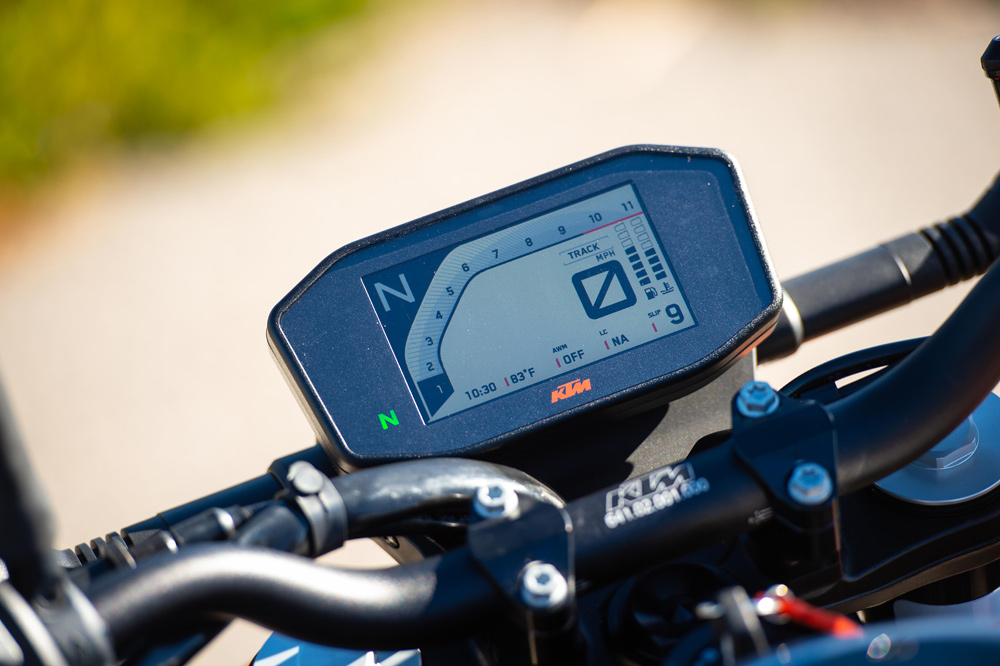 All of the various power modes and rider aid settings are intuitively selected from the 790’s full color TFT display
All of the various power modes and rider aid settings are intuitively selected from the 790’s full color TFT display
Also in its arsenal of sophisticated rider aids is Motor Slip Regulation (MSR), which works in conjunction with the cable-operated Power Assist Slipper Clutch (PASC) to smooth engine braking and mitigate rear wheel chatter under aggressive downshifts. Feeling frisky? The 790 has Supermoto ABS, which disengages rear wheel ABS, allowing you to lock up or back the rear in while remaining fully active up front, and a quickshifter works in both directions. The combination of all these features allows the rider to not only ride faster, but with more confidence and control as well. The beauty of it, though, is that it’s all integrated so seamlessly that you don’t even know it’s working.
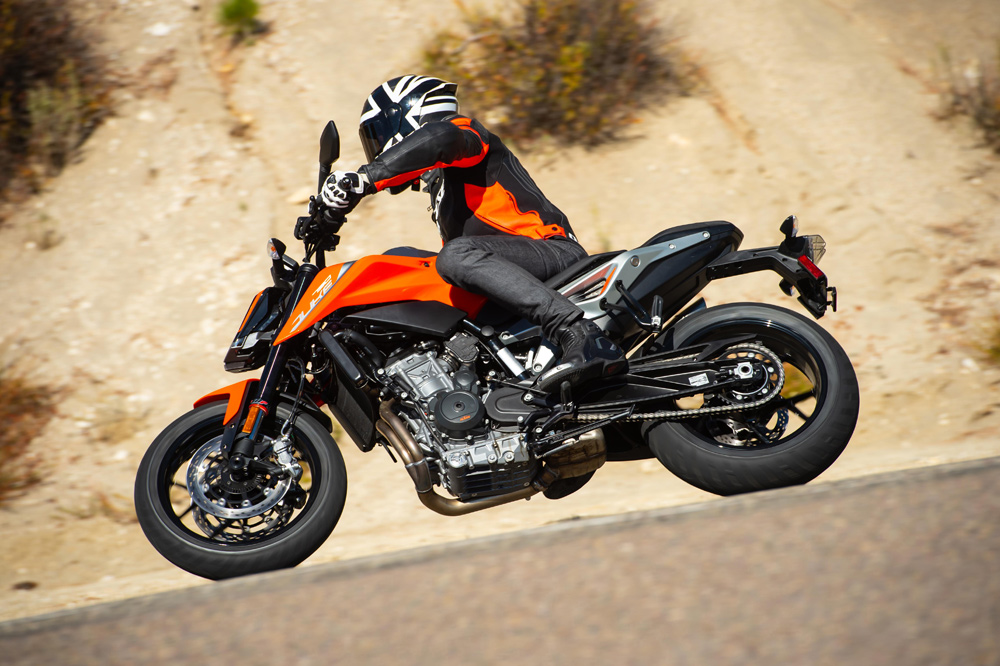 Aside from working flawlessly all day, one cool feature about the 790 Duke’s quickshifter is that you can reverse the shifting pattern to GP-style (one up, five down) without any additional parts or modification.
Aside from working flawlessly all day, one cool feature about the 790 Duke’s quickshifter is that you can reverse the shifting pattern to GP-style (one up, five down) without any additional parts or modification.
Speaking of seamless integration, the 790’s motor doubles as a stressed member of the frame, which in traditional KTM fashion is made from chrome molybdenum tubular steel. However, unlike its other Duke brothers, it’s not the typical trellis style frame we’re used to seeing. Rather, it’s more minimalistic, but it’s been fine tuned for optimal flex and rigidity to provide riders with better feel while simultaneously reducing overall weight. Making this possible was the employment of dual counter-balancers—one in front of the engine and one in the cylinder head—to help quell vibrations transmitted through to the rider.
Keeping with KTM engineers’ goals of reducing weight while ensuring each part served multiple purposes is a one-piece cast aluminum subframe, and it houses the entire intake system. Equally simple yet impressive in its design is the die-cast, open-lattice swingarm. Like the rest of the chassis, it’s also been engineered to be as light as possible while optimizing rigidity in certain areas, and flex in others.
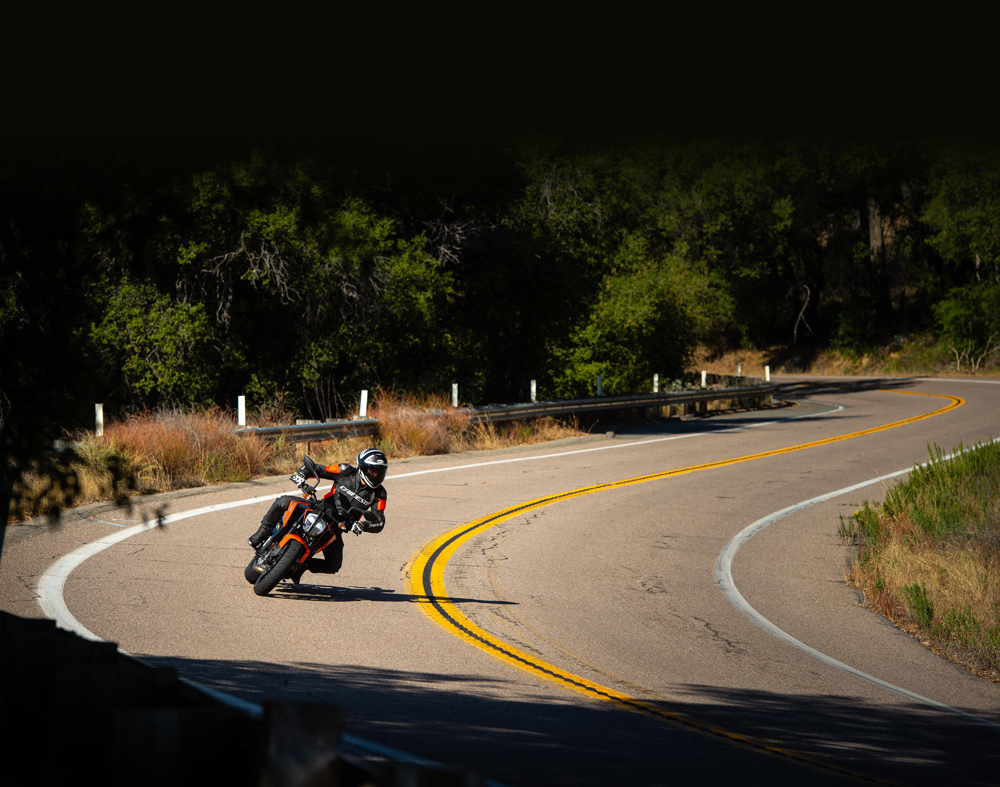 “The Scalpel” will perform anywhere you take it, but it earns its nickname when the pavement gets twisty.
“The Scalpel” will perform anywhere you take it, but it earns its nickname when the pavement gets twisty.
True to its name, “The Scalpel” has a sharp, 24-degree rake that provides quick, precise steering, and the ability to put the bike pretty much wherever you want. It’s totally stable in faster sweepers, too, thanks to its relatively long 58-inch wheelbase and a non-adjustable WP steering damper fitted to the lower triple clamp.
The 790 Duke is suspended with WP componentry featuring a 43mm non-adjustable, split-function fork, with compression and rebound damping handled separately by each leg. Out back you get a WP shock as well, but adjustable for preload only. Both the front and rear employ progressive springs, offering 5.5 and 5.9 inches of travel, respectively. On paper, the 790’s non-adjustable suspension might seem uncharacteristic of such a high-performance bike touted for its handling abilities. However, in reality, the WP units have precisely tuned internals, and paired with the progressive springs, offer a softer initial stroke that gets firmer further down. Overall, I would say the suspension is actually on the stiffer side of the spectrum as far as sport bike suspension goes—especially for being non-adjustable—but it makes spirited riding and elevated paces a lot more controlled and enjoyable.
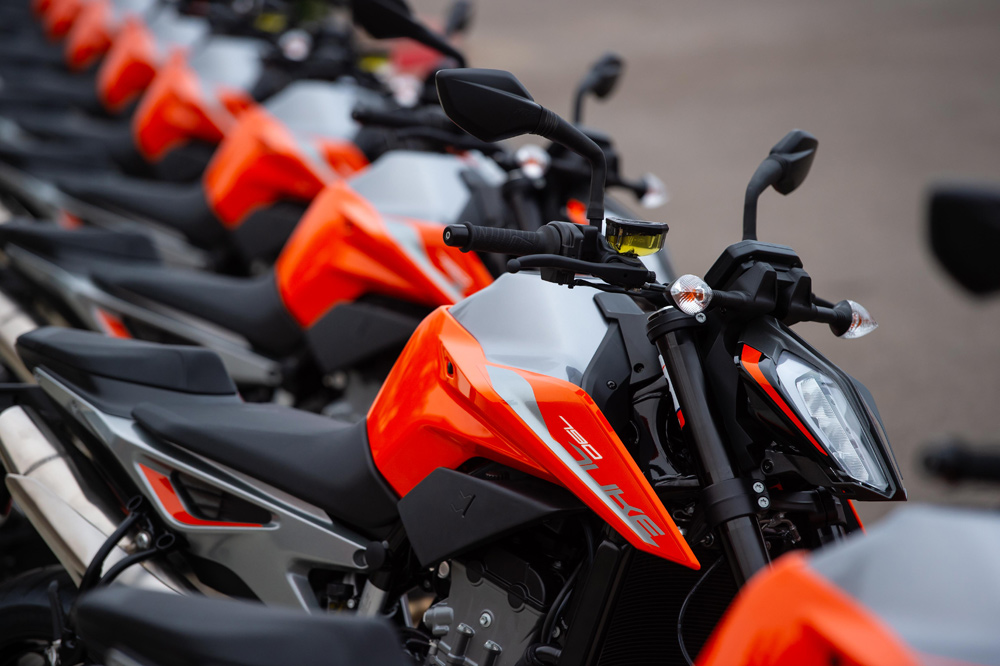 Styling is unmistakably Kiska, with lines so sharp you could cut yourself.
Styling is unmistakably Kiska, with lines so sharp you could cut yourself.
Enough with the tech already. What’s it like to ride?
Like I mentioned before, it’s basically the moto-version of your psycho ex-girlfriend, but in all the best ways. Simply put, the 790 Duke just wants to go fast and rail corners. As if looking at the sharp-edged, aggressive Kiska Design styling wasn’t indication enough, climbing aboard and firing it up instantly lets you know the 790 Duke means business as it roars to life. Knowing we’d be in for one helluva treat, we skipped right past Street and Sport modes, and went straight to Track. In addition to setting wheel spin tolerance, Track mode also allows you to tailor the throttle response with three settings: Street, Sport, and Track. Chris Fillmore explained that the Track response was too twitchy for the street, and really only works best in a racing environment. So, with Sport response selected, we were off.
To say the 790 Duke is eager-revving would be an understatement. The engine’s character and the way it builds power is such a rush. It feels incredibly linear and pulls super smooth from 3000 rpm right on up through 9000, but it’s around the 5000 rpm mark where it really starts pulling hard. Cycling through the gears with the KTM’s quickshifter is one of the best systems I’ve ever used, with minimal pressure required to grab the next gear—up or down. It works best with the throttle pegged on upshifts, and for downshifts it prefers you to be in the upper third of the rev range, but you could easily go all day without ever touching the clutch lever except for starting or stopping. I found that I preferred to blip the throttle and clutch my own downshifts most of the time, but only because that’s how my brain is wired. The light pull of the Power Assist Slipper Clutch paired with the back-torque-limiting Motor Slip Regulation really make you feel in tune with the motor.
Going fast is nothing if you can’t slow down, and helping in that department is a pair of radially-mounted, four-piston J.Juan calipers biting down on twin 300mm floating rotors up front, and a two-pot caliper paired with a 240mm disc out back. The 790 Duke’s engine braking does such a good job of keeping your speed in check most of the time, though, you rarely have to engage the brakes much. When you do, they provide great initial bite with progressively linear power and feel. My only complaint regarding the brakes, however, is at the lever. While both the clutch and brake levers are easily adjustable, I wish the radially actuated brake lever could be adjusted out even further. I only ever use one or two fingers, and the lever would hit my ring finger before providing maximum stopping power.
Keeping costs down was no doubt one of the main reasons for the 790’s non-adjustable suspension, and I tried my best all day to find its limits with no success. Sporty riding is, of course, where it shines brightest, and the WP units keep the Duke glued to the road. It’s only when cruising around town it feels somewhat harsh and on the stiffer side, but this is “The Scalpel” we’re talking about here, not “The Sofa.”
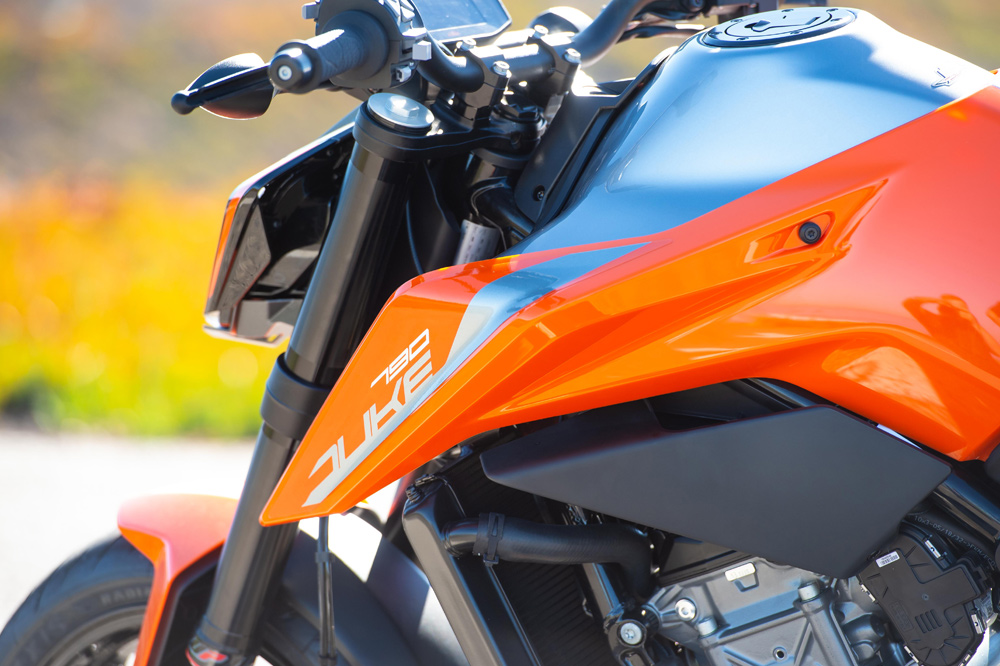 Front suspension is surprisingly non-adjustable.
Front suspension is surprisingly non-adjustable.
That being said, the 790’s ergonomics are spot on for a large variety of riders, but some might complain about the seat being on the firmer side, which in stock trim stands 32.5 inches tall. A lower, 31.7-inch seat is available from the PowerParts accessory catalog, and if that’s still too tall, you can drop it down even further to 30.7 via a lowering kit.
Perhaps my favorite ergonomic feature of the 790 Duke is its adjustable top triple clamp. Between the reversible risers and two mounting holes, it offers a combination of four different bar positions—something taller riders will certainly appreciate. The 30-inch tapered aluminum handlebar gives the rider great leverage and the ability to switch direction with minimal effort. Handling is so sharp that the bike is un-phased by midturn line changes to avoid a rock or gravel patch. This in turn also makes the 790’s handling more forgiving in the chance of a rider error, allowing you to quickly correct yourself without getting too squirrely.
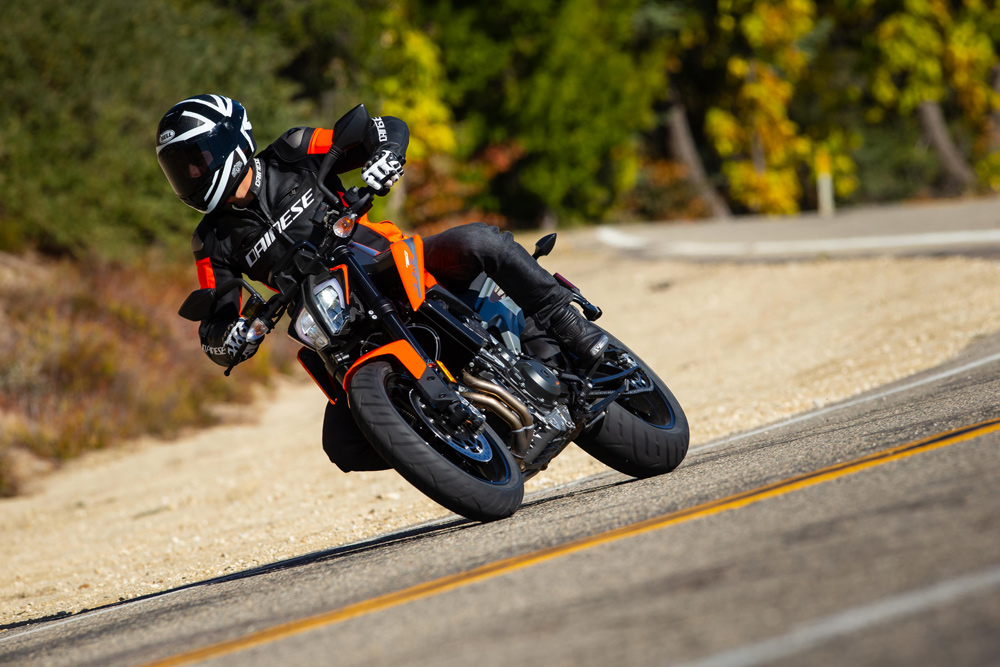 The 790 feels planted and composed whether flicking back and forth through tight switchbacks or railing longer sweepers.
The 790 feels planted and composed whether flicking back and forth through tight switchbacks or railing longer sweepers.
After an hour or so in Track mode with the throttle sensitivity set to Sport, I knocked the response down to Street, which I found the be the perfect combination. Street allowed you to keep a smooth, neutral throttle without any jerkiness. Later on in the day I bumped the ride mode down into Sport to see how it compared, and then again into Street. Both modes offered discernible steps in performance you could feel. While a faster, more experienced rider would prefer to keep it in Track mode to take full advantage of the 790’s performance, the other modes make riding this Duke more accessible and enjoyable for learning riders perhaps upgrading from the 390 Duke or similar entry-level bike.
The 2019 KTM 790 Duke is an absolute riot to ride that rewards its pilot in spades. Between its rowdy, yet silky smooth engine, its sporty but comfortable ergonomics, and its razor sharp but forgiving handling, this Duke could be the jack-of-all-trades naked sport bike many riders have been looking for. No, it’s probably not a bike you’ll want to tour on, but then again, nobody would stop you. If a well-sorted motorcycle that’s as comfortable to commute on as it is carving up the canyons or ripping up the racetrack is what you’re after, then the 2019 KTM 790 Duke is your ticket.
Chris Fillmore’s Pikes Peak International Hill Climb Winning 790 Duke
VIDEO | KTM 790 Duke at Pikes Peak 2018
What does it take to set a new PPIHC middleweight class world record on the KTM 790 Duke? Aside from being one of the world’s most talented racers, not that much apparently. Having raced America’s mountain on the 1290 Super Duke R before, Chris pitched the idea of doing it again on the 790. Big horsepower isn’t the key to going fast. While it does help, Chris wanted a more neutral bike that’s easy to ride with sharp handling so that he could change direction quicker and carry more corner speed—the 790 Duke fit that bill.
To get the 790 where Chris wanted it, he didn’t have to change very much, and the parts he used aren’t classified as unobtanium like most other high-end race bikes around the world. Aside from his custom Troy Lee Designs paintjob, every single part and alteration is available to consumers in the KTM PowerParts catalog.
Here’s what’s different from a factory fresh, showroom floor stock 790 Duke: Weight reduction was first and foremost, so the headlight and passenger seat were the first to go. Then an Akropovic Evo exhaust system was fitted for better throttle response, sound, and feel. Different triple clamps were paired to a fully adjustable WP fork with a straight-rate spring. The rear shock was also replaced with a three-way adjustable unit. Racing rear sets replaced the stock ones, as did Dymag wheels. Chris’ 790 got more aggressive J.Juan calipers and rotors to match. And finally, sprockets, of course were chosen to optimize gearing ratios.
Other than that, nothing else was touched, and there was no internal motor modification. When the 2019 790 Duke becomes available to the public, you too could own the same bike Chris rode to a new world record at Pikes Peak.CN
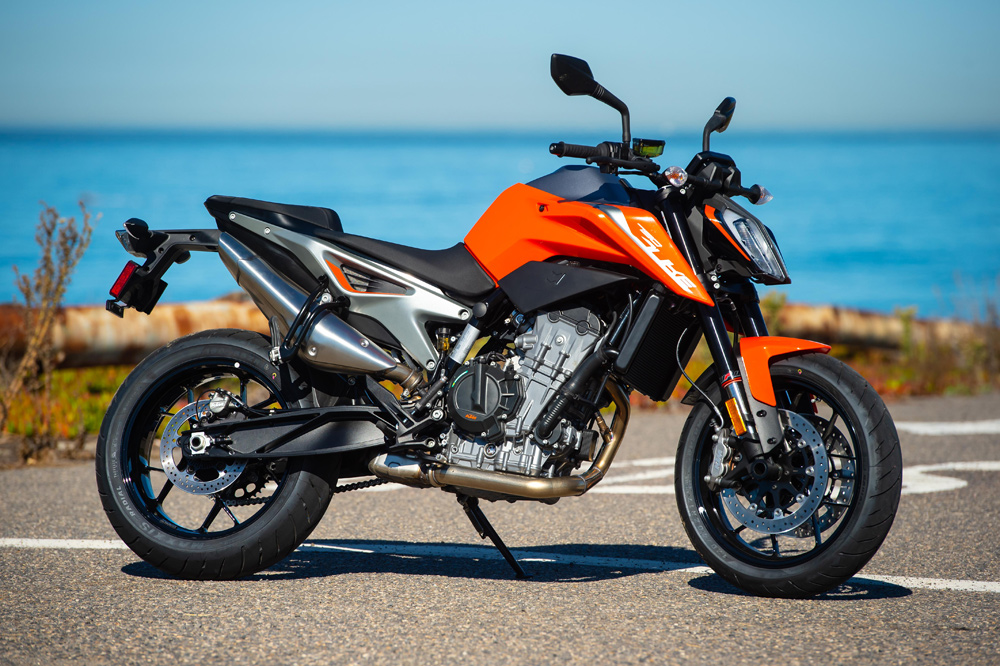
| SPECIFICATIONS |
2019 KTM 790 Duke ($10,499) |
| Engine: |
Liquid-cooled, DOHC, 4-stroke, Parallel-twin |
| Displacement: |
799cc |
| Bore x stroke: |
88 x 65.7mm |
| Compression ratio: |
12.7:1 |
| Clutch: |
Wet multi-plate |
| Transmission: |
6-speed |
| Chassis: |
Tubular steel trellis |
| Front suspension: |
43mm WP inverted fork, non-adjustable |
| Rear suspension: |
WP monoshock, preload adjustable |
| Front wheel travel: |
5.5 in. |
| Rear wheel travel: |
5.5 in. |
| Front brake: |
2 x 300mm semi-floating discs, radially mounted 4-piston calipers, Cornering ABS as standard equipment |
| Rear brake: |
240mm disc, 1-piston floating caliper, with Cornering ABS as standard equipment |
| Front tire: |
120/70 ZR17 in. |
| Rear tire: |
180/55 ZR17 in. |
| Rake: |
24° |
| Wheelbase: |
58 in. |
| Seat height: |
32.5 in. |
| 3.7 gal. |
3.7 gal. |
| Weight (dry, claimed): |
372.6 lbs. |
| Color: |
Orange, Black |